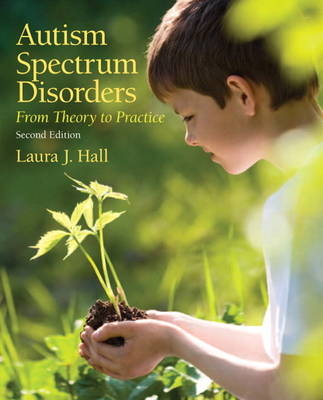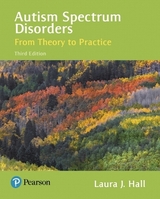
Autism Spectrum Disorders
Pearson (Verlag)
978-0-13-265809-6 (ISBN)
- Titel erscheint in neuer Auflage
- Artikel merken
Hall devotes a complete chapter to cultural and linguistic diversity and addresses ASD across the lifespan, including preschool, school-age and transitions. Updated with the latest research and strategies, this edition includes a new chapter on transitions, references to DSM-v, and captivating In Their Words accounts of what it is like to live with ASD.
Chapter One
Classification and the Physiological Approach
Chapter Objectives
Classification Systems of Autism Spectrum Disorders
Prevalence 5
What Causes Autism Spectrum Disorders?
Physiological Interventions
Working in Collaboration with Specialists
Suggestions for Discussion
Resources
Chapter Two
Assessment
Chapter Objectives
Screening Instruments
Diagnostic Processes
Addition Measures Used To Assess Outcomes
Assessments for Educational Planning and Intervention
Curriculum-Based Assessment and Monitoring Progress
Ongoing Progress Monitoring
Program Evaluation
Suggestions for Discussion
Resources
Chapter Three
Collaborating for Effective Implementation of Evidence-Based Practices
Chapter Objectives
Legislation Guiding Practice
Identifying Evidence-Based Practices
Implementing Evidence-Based Practices Effectively
CEC Code of Ethics for Educators of Persons with Exceptionalities
Implementing A Systems Approach
The Who, When, Where, What and Why of Effective Systems
Working Effectively With Paraprofessionals
Working Collaboratively With Families
Recomendations To and By Parents Regarding Evidence-Based Practices
Maintaining and Sustaining Effective Practice
Evolution of Facilitated Communication: A Strategy Without Evidence of Support
Selecting Evidence-Based and "New" Strategies
Suggestions for Discussion
Resources
Chapter Four
Applied Behavior Analysis: Increasing Skills
Chapter Objectives
Theoretical Basis for Applied Behavior Analysis
History of Applied Behavior Analysis and Autism
Key Concepts
Strategies Based on Key Concepts
Key Concepts Put into Practice
Ethical Applications
Research Support for Practice
Suggestions for Discussion
Resources
Chapter Five
Applied Behavior Analysis: Replacing Behavior
Chapter Objectives
Evolution of Applied Behavior Analysis to Decrease Behavior
Selecting Socially Important Behaviors
Reinforcement
Punishment
Motivating Operations
Observation and Measurement
Strategies Based on Key Concepts
Functional Communication Training
Self-Management
Token Economies
Combinations of Strategies
Key Concepts Put Into Practice
Research Using Applied Behavior Analysis to Decrease and Replace Behaviors
Suggestions for Discussion
Resources
Chapter Six
Developmental and Social-Relational Approaches
Chapter Objectives
Theoretical Basis for the Developmental and Social-Relational Approaches
The DIR/Floor Time Approach
Responsive Teaching
The Hanen Program
Relationship Development Intervention (RDI)
Enhanced Milieu Teaching
The Denver Model and Early Start Denver Model
Project Impact
Pivotal Response Treatment
The SCERTS Model
Key Concepts of the Developmental and Social-Relational Approaches Put into Practice
Research on the Developmental and Social-Relational Approaches
Suggestions for Discussion
Resources
Chapter Seven
Cultural Approaches
Chapter Objectives
Theoretical Basis for the TEACCH Approach
Key Concepts
Strategies Based on Key Concepts
Key Concepts Put into Practice
Research on Structured Teaching and the TEACCH Approach
Working in Collaboration with Diverse Families
Teaching in a Manner That Is Culturally Responsive
Encouraging Identity Development as an Educational Goal
Research Support for Practices Focusing on Culture
Suggestions for Discussion
Resources
Chapter Eight
Focus on Communication
Chapter Objectives
Theories of Language Development
Understanding Typical Communication Development
Communication Issues and Delays in Autism
The Importance of Communication
Enhancing Educator Skills as Communication Partners
Focusing on Oral Language
Using Augmentative and Alternative Communication (AAC) Systems
Addressing Deficits in Nonverbal Communication
Functional Communication to Replace Challenging Behavior
Strategies to Teach Complex Language
Designing an Evidence-Based Classroom to Facilitate Communication
Suggestions for Discussion
Resources
Chapter Nine
Building Social Skills and Social Relationships
Chapter Objectives
Theories of Social Development
Understanding Typical Social-Emotional Development
Social-Emotional Issues in Autism Spectrum Disorders
The Importance of Relating to Others
Enhancing Educator Skills as Social Partners
Addressing Joint Attention and Social Referencing
Teaching Social and Play Skills With Young Peers
Additional Strategies Used to Increase Social Skills and Social Interaction
Love and Marriage?
Issues and Research Questions
Suggestions for Discussion
Resources
Chapter Ten
Transition to Adulthood
Chapter Objectives
Legislation guiding Practice
Best Practice in Developing the Individualized Trasition Plan (ITP)
Research on Best Practices for Adults With ASD
Implementing Evidence-Based Practices
Preparing For Post School Outcomes
Adult Services and Supports
Advocating for Policy Change
Call for Optimism and Action in the Creation of Communities of Practice
Suggestions for Discussion
Resources
References
Name INdex
Subject Index
| Sprache | englisch |
|---|---|
| Maße | 190 x 231 mm |
| Gewicht | 436 g |
| Themenwelt | Sozialwissenschaften ► Pädagogik ► Berufspädagogik |
| Sozialwissenschaften ► Pädagogik ► Sonder-, Heil- und Förderpädagogik | |
| ISBN-10 | 0-13-265809-7 / 0132658097 |
| ISBN-13 | 978-0-13-265809-6 / 9780132658096 |
| Zustand | Neuware |
| Haben Sie eine Frage zum Produkt? |
aus dem Bereich



